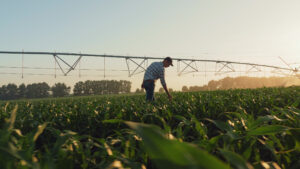
While most workers spend July counting down the days to their holidays, arable farmers spend these weeks anxiously watching their crops — and the weather forecast — ahead of the harvest.
However this year the anxiety is building. Dry weather and soaring fuel and fertiliser costs mean that the yield and margins on the crops they’ve planted are eroding before their eyes.
“Unless we get some rain, we will start to see a significant impact on wheat, and on sugar beet and potatoes, too,” said Richard Bramley, who farms near Kelfield, south of York. “Potatoes are a high-value crop, so the margin erodes very quickly.”
This week Bramley, 54, will start harvesting winter barley and he expects the yield to be on a par with an average year, as he does for his crop of oats. However, the price of the ammonium nitrate fertiliser he uses has more than doubled from £260 a tonne last year to more than £700, having peaked at £1,000 a tonne in March.
Fuel has doubled in price, even for the reduced tax “red diesel” used for agricultural machinery and off-road vehicles. And the surge in the cost of “the three Fs” of fertiliser, fuel and feed mean that the business model used for centuries — using the money from last year’s crop to plant and raise this year’s — is, in Bramley’s view, “not working”.
That will have an impact on supermarket shelves. The need for farmers to recoup at least some of these costs will push up the price of next year’s crop and reports this month of £9 tubs of butter may not be a short-lived phenomenon.
“Some people call farming a gamble, and you’re always trying to hedge your bets, but the risk factors that are coming into play are multiple and more extreme now,” Bramley said. “Having the confidence to plan ahead is more difficult. Normally the system functions, but everything going up and the size of the price increases have upset the apple cart.”
Farmers may not have experienced the full benefit of higher prices this year for their crops, because they often sell a proportion ahead of time to guarantee a certain income, meaning that they miss out if the market price later rises above that level. Wheat prices were already increasing in 2021, but they jumped after Russia’s invasion of Ukraine in February, because Ukraine is one of the world’s top five wheat exporters. Prices have eased from their highs in recent weeks, but are still at about £250 a tonne, compared with £160 last year.
For livestock farmers, animal feed including wheat is their biggest cost and a price jump of such size has had a dramatic impact on what they are spending. Paul Tompkins, 42, has a dairy herd of 350 cows on his farm near Pocklington in East Yorkshire. The cost of feed has risen from £200,000 in 2021 to an estimated £350,000 this year.
“Dairy cows in the 21st century are like finely tuned athletes,” he said. “Our cows have their own nutritionists. We can’t cut back on feed for them, it’s like saying feed your children less. And if we cut back or cut out an additive such as an amino acid, it will reduce the amount of milk they produce and our total income.” Like the grain market, the milk market is driven by international supply and demand. A shortage worldwide has pushed up prices, so dairy farmers “are getting enough to pay the bills”.
The bad news for consumers and policymakers seeking to bring inflation under control is that “the cost of feed now is still going to be in system in a few more years”, Tompkins said. “A calf born today will only become part of my milking herd in three years’ time, so the cost of rearing her now is going to be borne in future.”
For horticulture businesses growing fruit and vegetables, prices are dictated by the supermarkets they supply rather than by international markets. Only now are retailers catching up with the price they are paying to farmers, according to Guy Poskitt, 59, who grows vegetables including carrots and parsnips on 4,000 acres near Selby, North Yorkshire, as well as on contract farms in Lancashire and Scotland.
“It’s been a battle to get retailers to recognise the inflationary pressure,” he said. “We’re in successful negotiations now, but it’s six months later.” The cost increase for growing carrots has been about 20 per cent this year, compared with a typical increase of 1 per cent to 2 per cent each year.
The second challenge faced by the horticulture sector is the lack of workers to pick and pack fresh produce. It was reported this week that huge quantities of salad vegetables have been left to rot in the fields owing to a lack of pickers.
Poskitt said his business struggled to hire enough people to pack carrots before busy times including Christmas and Easter and had to “pay a lot more” to get the extra hands. Combined, higher costs for fertiliser and fuel and the lack of staff meant that “everybody I know in the horticulture sector has cut back” because they were struggling to cover their costs, he said. This is creating a vicious circle because less supply drives up the cost for consumers and adds to inflation across the board.
Farmers say that they are doing what they can to mitigate their costs. Poskitt is automating as much of the process of picking and packing as he can, although the robotic equipment comes at its own cost, while Bramley reduced his fertiliser use by 15 per cent in 2021 and expects to do the same this year.
Tompkins believes that the government could help the dairy sector to invest more in increasing production, and therefore to bring down the cost to consumers, by putting the brakes on new regulations, such as charging for Environment Agency permits.
Although “2023 is going to get really interesting in the food market”, Bramley said, for the next few months his focus will be on the crops ripening in the fields and the amount of rain that falls.
Read more:
Rising costs of fertiliser, fuel and feed combine to turn up the heat on farmers




